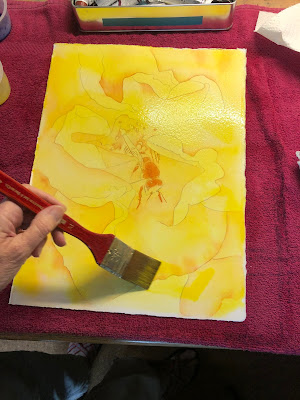This is a different time for all of us. Since March we've been navigating a life of in-person restrictions. Fortunately, this does not necessarily mean isolation.
This year I've taken three online workshops. Each artist instructor used a combination of Youtube streaming and Zoom meeting. Of course there were glitches as they and we learned to use these platforms. Many opportunities to practice patience and acceptance. And many exciting paintings, many new skills and techniques, and so much wisdom!
San Francisco artist Guy Magallanes taught us how to paint realistic and brilliantly colored flowers. In each section of the painting we wet the area, then dropped in the colors and let the colors mix on the paper. Sometimes we tilted the paper or added a bit more water to let the colors really meld. The key is not to touch the area too much with the brush, just let the paint and water do its thing.
 |
| Then painting along with him |
Guy had us prepare each color in a cup, so that we had enough to really saturate the area when needed. With this glazing technique there were several layers of paint, and we let it dry in between.
This rose was my own creation afterwards. I enjoy the wet on wet mixing technique and the glazing. I sometimes use frisket to mask an area. Not so crazy about erasing all the pencil lines and trying to make it super realistic, so I don't do those things.
The next online workshop was with Minnesota artist Andy Evanson. He taught me that painting a value study alongside a full color painting has several benefits.
For one, the first layer of paint on the value study is all the medium value shapes, and whenever possible, these shapes are linked together. This really helped me see those big shapes in the scene. Once we had that first layer on the value study, we began to paint the full color painting, first with a light wash (the underpainting), then the medium value shapes. Even though they're different colors, it's ok to connect them, to let them meld a bit at this stage.
Once the medium shapes were painted, we went back to the value study and painted the darks: shadows, masts, darker reflections. Then put those darks on the color painting.
Another benefit of the value study is that we got to practice the strokes and techniques we wanted to use to suggest those tree branches or those water ripples before we did them on the finished piece.
 |
| Colorado mountain scene: first wash with medium shapes and finished painting |
These two were great sky practices:
 |
| Farm at sunset, painted in the workshop |
Then I got to do my own thing! Apply this awareness of shapes and values to my own creations.
 |
| Here It Comes |
 |
| Detail of Here It Comes |
 |
| Taita Imbabura |
 |
| Tomato Rows Uruguayan master watercolor painter Alvaro Castagnet taught us to "exploit the nature of watercolor" and stay loose and fresh. |
 |
| Alvaro explaining his process |
I remember watching his first demonstration, admiring his audacious style, when suddenly he made a big wet stroke which seemed to ruin the painting. I thought, "Oh, how embarrassing to make such a big mistake in front of hundreds of people!" He did not "correct" that mistake, just continued on with his loose style, and the painting came out wonderfully.
I later realized that he paints EVERY painting that way. In fact, when a section of the painting starts to look too crisp and perfect, he sprays it with water and smudges it. When I asked Alvaro how he decides to make those audacious strokes or smudges, and how he stays so courageous, he replied, "Don't worry, we're all afraid of failing. My attitude when a start a painting is, I don't care... And remember, a good watercolor painting is a collection of mistakes."
 |
| Practicing people |
 |
| My version of San Francisco scene |
 |
| My version of Cafe Bulla |
While I'm tired of being online, and I miss the personal touch that's possible in the in-person workshops, I'm so grateful to have the online option! There are benefits of an online class: the demonstrations can be paused, rewound, and watched multiple times. I can eat breakfast as I watch the demo. I can study with someone from a faraway country without paying airfare.
I don't know that I'll ever be as detailed a painter as Guy, as successful as Andy, or as audacious as Alvaro. But those workshops helped me reach another level in my painting, for sure. Hopefully, you'll see some more audacity in my future paintings!







Comments
Post a Comment